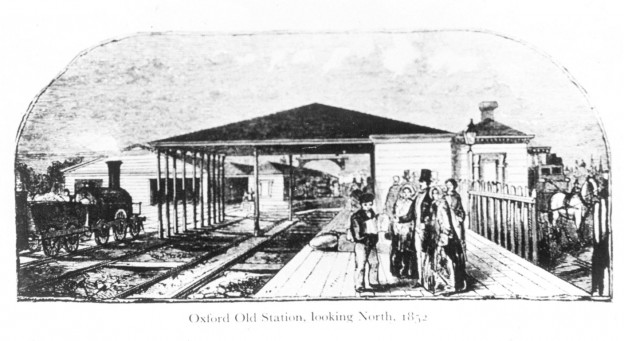For our first meeting in 2015 we welcomed back Liz Woolley who gave us an excellent talk on “How the Coming of the Railway Changed Oxford”. She described the background development of the railways in Britain and how Oxford joined the network. The railway in Oxford then had profound effects on the landscape, the nature of trade and the population level, all of which were described with the aid of well chosen illustrations.
From early beginnings with the Liverpool to Manchester line in 1830 the number of route miles increased to 6000 in1851 and peaked at around 20,000 in 1914. Brunel’s Great Western Railway reached Steventon in 1838 but not until 1843 was a Bill approved to build a branch line to Oxford. The University objected to the original plan for a line through Iffley village but also on moral grounds, not wishing the undergraduates to have easy access to the fleshpots of London. The route finally accepted terminated at a station at Grandpont, South West of Folly Bridge. There was opposition to this route also, particularly on the siting of a bridge to carry the Abingdon Road over the railway. John Towle, who owned the nearby Paper Mill hastily built a small house of wood and paper on the route, some say to claim compensation. This house was enlarged over many years and stood on a site opposite the Redbridge Waste site. It was demolished in 1998.
In 1851 the rival (standard gauge) railway LNWR, later LMS, came to Oxford and built a station at the site of the present Said Business School. This station was closed in1951 and moved to the Buckinghamshire Railway Centre at Quainton near Aylesbury in 1999. In 1852 the Grandpont station was closed and a new station built on the current site on Botley Road. In the 1880’s a housing development was built on the old site. In 1886 a spur was built to the Gas Works and the elegant bridge over the river still exists. Another relic of the old railway, the swingbridge over Sheepwash Channel, also still exists and preservation work is planned to prevent further deterioration. In 1908 a number of Halts were introduced for a steam carriage but this service was soon superceded by road transport.
The railways led to big reductions in Coach and Canal traffic but led to large increases elsewhere. Brewing, furniture removals, the Jam Factory, cattle pens and rather surprisingly, temperance hotels all appeared in the proximity of the stations. Between 1841 and1901 the population of Oxford doubled and new suburbs were built, often to house railway workers e.g. Osney Island, New Hinksey and Cripley Road. Tourism grew and became more commercialised with new hotels including the Randolph being constructed to replace some of the coaching inns which had earlier closed.
Our next meeting is on Thursday February 12th when Mark Davies will talk about “Motoring and Transport in the Forties”. Visitors (£3) are most welcome.

